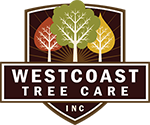Preventative tree care is a proactive measure that seeks to avoid issues with your trees health, structure, and appearance before they happen. As Westcoast Tree Care has made its way through the Olympia, Washington area we’ve seen countless examples of tree damage that could have been avoided with proper care and maintenance.
Obviously no one wants to discover their trees have serious issues after the fact. Unfortunately, after-the-fact discovery often involves costly solutions: damage repair, tree removal, and more. As we’ve provided tree care to our customers in Olympia, Washington we’ve been asked on numerous occasions what a homeowner can do to protect their trees.
Regular evaluation of the health and structural condition of your trees is necessary to protect this wonderful investment. Today we outline a number of steps that you can take to evaluate whether or not your trees are in need of help.
Is Your Tree a Hazard Tree?
In a nutshell, a hazard tree is any tree that has severe enough structural defects that can lead to the tree, or a section of the tree, falling with the result of causing physical injury or property damage.
For a tree to be classified a hazard tree, people, structures, or vehicles must fall within the falling distance of the tree or section of the tree that fails.
It is important to note that most states will hold a tree owner responsible for injury, death, or damage caused by a defective tree. The law requires you to manage your trees responsibly and to recognize when your trees pose a hazard.
Preventative Tree Care: Signs of Tree Hazards
First off, you should regularly inspect your trees to evaluate their health and structural integrity. Preventative tree care emphasizes being proactive, and there is no better way to take care of tree issues before they become hazardous than regularly inspecting your trees.
When inspecting your trees look for:
- Signs of vitality: Does the tree grow as vigorously as trees of its type? Evaluate the leaf color and condition, as well as the size of the leaves and leaf cover. Often signs of disease are first manifested in the leaf color and health. Signs of disease include discoloration and premature defoliation.
- Dead Branches: Dead limbs, often called “Widow Makers” can fall at any moment. It does not necessarily take a wind storm or other disturbance to cause a dead limb to fall. Dead limbs should be removed immediately.
- Disease and Damage: When inspecting your trees look for open wounds, soft spots, cankers, rot, and fungus. Excessive disease and damage are often sounds of serious issues with a tree and need to be addressed with a sense of urgency. While the number of tree diseases are countless and varied they can have a disastrous effect on your trees. If you suspect tree disease of any sort, contact an ISA Certified Arborist such as Westcoast Tree Care to assist you.
- Root Decay: Look for signs of root decay. Signs of root decay include fungi, or “mushrooms”, near the trunk and the base of the tree. Root decay is often difficult to detect and these signs do not always mean root decay is present. If you do suspect root decay contact an ISA Certified Arborist such as Westcoast tree to assist you in determining whether root decay is an issue.
- Trees with Forked Trunks: Forked trunks are signs of potential tree weakness. Forked trunks that have grown outward instead of upward should be carefully evaluated. Proper tree pruning of the forked trunks, when applicable, can often address this issue.
- Lopsided Trees: A lopsided tree is a potentially hazardous situation. A tree that has suddenly shifted should be addressed immediately as removal may be necessary. Contact an ISA Certified Arborist such as Westcoast Tree Care to assess the situation.
For more in-depth information on assessing your trees for hazards visit: Hazard Tree Guidelines For Forest Service Facilities and Roads in the Pacific Southwest Region
The Takeaway
Preventative tree care is a proactive measure meant to address issues with your trees before they become problematic. As Westcoast Tree Care has provided service to Olympia, Washington we’ve been asked by our customers what they can do to ensure the health and integrity of their trees.
Our list of suggestions includes regular inspections of your trees. While inspecting we suggest looking for signs of damage, disease, death, and more. When issues arise, we highly recommend contacting an ISA Certified Arborist such as Westcoast Tree Care to assist you in evaluating the health and integrity of your trees.
Westcoast Tree Care offers a variety of tree care services, including pruning, windsail reduction, hazard tree removal, deadwood removal, and more. Contact us today to learn how Westcoast Tree Care can assist you with all of your preventative tree care needs!








